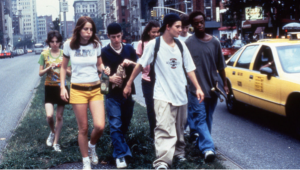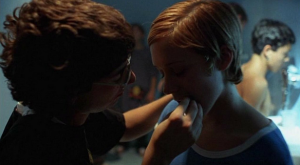25 Kids (1995)
Difference, Power, and Oppression in Kids
by Joshua Hewitt
Stepping into the chaotic urban landscape of Kids, I find myself drawn into a narrative that attempts to unravel the complex threads of difference, power, and oppression. Larry Clark’s direction and Harmony Korine’s writing have converged to create a cinematic experience that not only captures the gritty essence of youth culture but also delves unapologetically into the dynamics that shape these characters’ lives. Whether you’re a seasoned viewer of this film or have yet to discover its impact, the themes it grapples with are not only relevant but demand our attention and contemplation. My central goal is to dissect how Kids navigates the intricate terrain of discrimination. By immersing ourselves in the world of cinematography, editing choices, soundscapes, and the overall audiovisual atmosphere, we can begin to gain new insights on power struggles, and how they shape the world around us.
Kids emerged at a crucial juncture in both the cinematic landscape and societal dynamics. The mid-90s were a time of significant cultural shifts, characterized by the emergence of alternative youth subcultures, the AIDS crisis, and debates around the commodification of rebellion. Against this backdrop, the film’s plot and characters directly engaged with the pressing issues of the era. The narrative’s exploration of teenage sexuality, drug use, and urban youth culture served as a reflection of the zeitgeist, shedding light on the complex realities and challenges faced by adolescents in a rapidly changing world. As Roger Ebert states, “What is interesting is that you can hardly even see Manhattan in this movie; the camera, like the characters, sees only this sad youth culture. What is not human and between 12 and 17 essentially does not exist.”

In the making of Kids an interesting intersection can be found in its portrayal of diversity, power dynamics, and discrimination. The cast was primarily comprised of unknown and non-professional actors, many of whom came from diverse backgrounds. This lent an authentic layer to the film’s depiction of urban youth culture, emphasizing the experiences of those who might not have been traditionally represented in mainstream media. Additionally, the film’s unvarnished approach to depicting the characters’ lives, including their struggles and vulnerabilities, served to humanize them beyond mere labels of race, sexuality, or ability. This can be shone in a scene depicting the thought of the main character. As main character Telly puts it “When you’re young, not much matters. When you find something that you care about, then that’s all you got. When you go to sleep at night you dream of p****. When you wake up it’s the same thing. It’s there in your face. You can’t escape it. Sometimes when you’re young the only place to go is inside. That’s just it – f****** is what I love. Take that away from me and I really got nothing.”
However, it’s worth noting that while the film made strides in representing a diverse cast, its portrayal was not immune to certain limitations. The majority of the characters were indeed white, and the complexities of intersectionality were not explored to a great extent. The film’s focus on a specific subculture within urban youth culture might have inadvertently sidelined other perspectives and experiences. Nevertheless, Kids undeniably made a mark by pushing boundaries and offering an unfiltered glimpse into the lives of its characters, whose diversity and struggles captured the spirit of a generation navigating the tumultuous landscape of the 90s.
Discrimination in casting or production could potentially have occurred, although specific information about the casting and production process of Kids might not be readily available. However, given the time period and the industry norms of that era, it’s possible that certain biases or limitations could have influenced casting choices or on-set dynamics. In terms of scenes, characters, themes, and cinematic techniques that highlight the representation of discrimination in the film. The film’s exploration of urban youth culture inevitably touches upon issues of race and socioeconomic status. Scenes depicting characters from different backgrounds interacting, or the lack thereof, could offer insights into how discrimination is subtly or overtly represented. For example, scenes where characters from diverse backgrounds are shown interacting and clashing might shed light on racial tensions and prejudices.
Kids doesn’t shy away from depicting explicit sexual content and the power dynamics that can arise from such encounters. The portrayal of sexual relationships, consent, and the consequences of unprotected sex can provide a lens to analyze how the film handles issues of gender and sexuality, potentially revealing discriminatory attitudes or power imbalances. Paying attention to the language used by characters can provide valuable insights into the film’s approach to discrimination. The use of slurs, derogatory terms, or demeaning language can be indicative of the film’s stance on these issues.
Analyzing the portrayal of characters who might be marginalized based on their race, sexuality, or other factors can offer a nuanced perspective on how discrimination is encoded. How these characters are treated by the narrative, other characters, and the overall framing can provide valuable context. Such as the women who are often depicted in the film as just objects of sexual gratification. In the movie, Telly says “But like, if you deflower a girl man, man, you’re the man. No one can ever do that again. You’re the only one. No one, no one, has the power to do that again.” The film’s use of visual cues, lighting, camera angles, and editing can also contribute to the representation of discrimination. Scenes that highlight the isolation or vulnerability of certain characters, for example, could reflect the impact of discrimination.

I chose this film because I like how it contrasts with the common narrative threads of most Hollywood films these days. As a former drug addict, I relate to the grittiness and a lot of the scenes depicted in the movie. I enjoy the eclectic style of Harmony Korine’s writing, and the different ways he conveys messages. The different perspectives he brings to the forefront are a refreshing change to what’s commonly seen in media.
This journey through the film’s themes prompts us to consider its significance in a broader context. The exploration of discrimination, power dynamics, and marginalized perspectives acts as a mirror reflecting aspects of our own society. The issues faced by the characters might have evolved, but the core struggles remain eerily familiar, underlining the film’s continued relevance. Despite the passage of time, many individuals continue to grapple with issues of identity, privilege, and systemic bias, making Kids not only a lens into the past but a bridge to understanding our current societal landscape.
In terms of recommendation, Kids is undoubtedly a challenging watch. Its unflinching portrayal of explicit content and harsh realities can be unsettling, particularly for sensitive viewers. However, its potency lies in its ability to spark conversations about topics often left unaddressed. For those seeking a thought-provoking cinematic experience that confronts the complexities of difference, power, and oppression head-on, “Kids” offers an unfiltered and often uncomfortable look into the lives of its characters. Its impact, though divisive, cannot be denied, making it a film worth considering, not merely for its cinematic prowess but for its capacity to ignite discussions that resonate long after the end of the film.
References
Ebert, Roger. “Kids Movie Review and Film Summary (1995): Roger Ebert.” Movie Review and Film Summary (1995) | Roger Ebert, www.rogerebert.com/reviews/kids-1995.
Lim, Dennis. “The Return (And Reform?) Of Harmony Korine.” New York Times, 27 Apr. 2008.
Locker, Melissa. “Harmony Korine on Kids: ‘It Would Be Impossible to Make That Film Now.’” The Guardian, 22 June 2015.
Staff, Vice. “Harmony Korine Talks About the Inspiration Behind His Movie ‘Kids.’” Vice, 25 Oct. 2017.
Trilling, Daniel. “Imperfect Harmony.” New Statesman, 2008.

